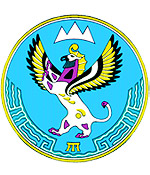Altai |
|
|
|
| Übersicht – Contents: | |
Altai |
|
|
|
| Übersicht – Contents: | |
Flagge – Flag: |
|
 |
Nationalflagge – national flag, Seitenverhältnis – ratio = 1:2, Quelle/Source: nach/by: Flaggen Enzyklopädie |
historische Flaggen – historical Flags: |
|
 |
1992–1994, Nationalflagge – national flag, Seitenverhältnis – ratio = 2:3, Quelle/Source: nach/by: Wikipedia (EN) |
 |
1994–2003, Nationalflagge – national flag, Seitenverhältnis – ratio = 2:3, Quelle/Source: nach/by: Wikipedia (EN) |
Bedeutung/Ursprung der Flagge – Meaning/Origin of the Flag: |
|||||
| Die Flagge wurde am 02.07.1992 angenommen, im Format 1:2. Zwischen 1994 und 2003 war das Format der Flagge offiziell auf 2:3 abgeändert gewesen. | The flag was adopted on 2nd of July in 1992, in the format-ratio of 1:2. Between 1994 and 2003, the format-ratio of the flag had been officially changed to 2:3. | ||||
| Die Farbe Weiß steht für Religiosität und Glauben und das friedliche Zusammenleben der Völker des Landes. Blau steht für den Himmel, die Berge, Flüsse und Seen. | The color white stands for religiosity and faith and the peaceful coexistence of the different peoples of the country. Blue stands for the heaven, mountains, rivers and lakes. | ||||
| Die blaue Farbe in der Flagge lässt aber Rückschlüsse auf das Volk der Altaier zu, die früher Bergkalmüken genannt wurden. Die Altaier, die sich selbst Oiraten nennen, gehören zu den Turkvölkern. Viele Mongolische oder auch Turkvölker haben gemeinsame Wurzeln, und als Farbe ihrer Rasse gilt Blau. | The
color blue in the flag permits inferences to the nation of the
Altaians, which were former called Mountain Kalmykes. The Altaians,
which name themself Oirates, belong to the Turk people.
Many Mongolians or even Turk people have common roots, and the colour
of their race is blue.
|
Quelle/Source:
Flaggen Enzyklopädie,
Volker Preuß |
| |||
Wappen – Coat of Arms: |
|
 |
Wappen der Republik Altai – coat of arms of the Republic of Altay Quelle/Source: Russiatrek |
Landkarten – Maps: |
geographische Lage in Russland – geographical position within Russia: |
Landkarte des Landes – map of the country: |
Zahlen und Fakten – Numbers and Facts: |
|
|
|
|
|
|
|
|
|
|
|
|
|
|
|
|
|
|
|
|
Geschichte: |
|
bis 1756
· Teil der Dschungarei 1763 · russische Eroberung 1919 · Errichtung der Sowjetdiktatur 1922 · Gründung des Autonomen Bezirks der Oiraten 1948 · Umbenennung in Autonomer Bezirk Gorno-Altai 25.10.1990 · Gründung der Gorno-Altaiischen ASSR 03.07.1991 · Umbenennung in Gorno-Altaiische SSR 31.12.1991 · die Sowjetunion löst sich auf, die Verfassung der Russischen Sozialistischen Föderativen Sowjetrepublik (RSFSR, Russland), ein ehemaliger Teilstaat der Sowjetunion bleibt vorerst in Kraft Mai 1992 · Umbenennung in Republik Hochaltai (Gorny Altay) 12.12.1993 · Umbenennung in Republik Altai 25.12.1993 · eine neue Verfassung für Russland (Russische Föderation) tritt in Kraft, das Verhältnis zu den Gliedern der Föderation wird damit neu geregelt |
History: |
|
to 1756
· part of Dzhungaria 1763 · Russian conquest 1919 · establishing of the Soviet dictatorship 1922 · establishing of the Autonomous District of the Oyrots 1948 · rename to Autonomous District of Gorno Altay 25th of October 1990 · foundation of the Gorno Altayian ASSR 3rd of July 1991 · rename to Gorno Altayian SSR 31st of December in 1991 · the Soviet Union dissolves, the constitution of the Russian Socialist Federative Soviet Republic (RSFSR, Russia), a former substate of the Soviet Union, remains in force for the time being May 1992 · rename to Republic Gorno Altay 12.12.1993 · rename to Republic Altay 25th of December in 1993 · a new constitution for Russia (Russian Federation) comes into force, and the relationships with the members of the federation is re-regulated in this way |
| Quelle/Source: Atlas zur Geschichte, World Statesmen, Russiatrek, Wikipedia (D) |
Ursprung des Landesnamens – Origin of the Country's Name: |
|
| Das Wort "Altai" ist kirgisischen Ursprungs. "Alty Ai" heißt auf Kirgisisch "Sechs Monate". Damit daben die Kirgisen die Reisezeit von Ihren Weidegründen bis zum Altai auf eine ganze Gebirgsregion übertragen. | The word "Altay" is of Kyrgyz origin. "Alty Ai" means in Kyrgyz "six months". Thus the Kirghiz transferred the journey time from their pasture grounds up to the Altai to a whole mountain region. |
| Quelle/Source: Altynbek und Kanat | |